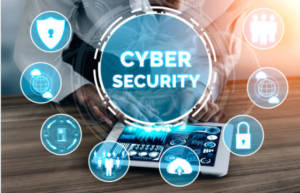Table of Contents
ToggleCybersecurity In The Digital Age
Cybersecurity In The Digital Age: Safeguarding Your Online World
In Today’s Rapidly Evolving Digital Landscape, Where Technology Is Seamlessly Integrated Into Every Aspect Of Our Lives, The Importance Of Cybersecurity Cannot Be Overstated. As We Become More Reliant On The Digital Realm For Communication, Commerce And Information-Sharing, The Threats To Our Online Security Have Also Esc alated. This Article Delves Into The Intricacies Of Cybersecurity In The Digital Age, Highlighting The Challenges We Face And Providing Actionable Insights To Protect Ourselves From Potential Cyber Threats.
Table Of Contents
- Introduction
- Understanding Cybersecurity
- The Evolution Of Cyber Threats
- Common Cybersecurity Vulnerabilities
- Importance Of Strong Passwords
- Crafting Unbreakable Passwords
- Implementing Two-Factor Authentication
- Securing Your Devices
- Keeping Software Up To Date
- Utilizing Antivirus And Anti-Malware Programs
- Safe Browsing Practices
- Recognizing Phishing Attempts
- Avoiding Suspicious Websites
- Social Engineering And Identity Theft
- Understanding Social Engineering Attacks
- Safeguarding Personal Information
- Data Encryption And Protection
- Importance Of Encryption
- Securing Sensitive Data
- Network Security
- Setting Up Firewalls
- Regular Network Monitoring
- Emerging Technologies In Cybersecurity
- Artificial Intelligence And Machine Learning
- Blockchain For Enhanced Security
- Cybersecurity For Businesses
- Protecting Customer Data
- Training Employees On Security Protocols
- Government Regulations And Compliance
- GDPR And Data Privacy
- NIST Framework And Cybersecurity Standards
- Cybersecurity Ethics And Digital Responsibility
- Promoting Ethical Hacking
- Educating The Next Generation
- Conclusion
Introduction
In An Era Where A Significant Portion Of Our Lives Is Conducted Online, The Rapid Rise Of Cyber Threats Has Brought The Issue Of Cybersecurity To The Forefront Of Discussions. The Digital Age Has Ushered In Unparalleled Convenience, But With It Comes A Pressing Need To Secure Our Online Presence.
Understanding Cybersecurity
Cybersecurity Involves A Series Of Measures, Protocols And Technologies Designed To Safeguard Digital Systems, Networks And Data From Unauthorized Access, Attacks And Damage.
The Evolution Of Cyber Threats
As Technology Advances, So Do The Tactics Employed By Cybercriminals. What Started As Isolated Hacks Has Evolved Into Sophisticated, Large-Scale Attacks That Can Cripple Entire Organizations.
Common Cybersecurity Vulnerabilities
Vulnerabilities Exist In Software, Hardware And Human Behavior, Making It Crucial To Address Potential Weak Points In Your Digital Defense Strategy.
Importance Of Strong Passwords
Crafting Unbreakable Passwords And Implementing Two-Factor Authentication Are Vital Steps In Fortifying Your Online Accounts Against Unauthorized Access.
- Crafting Unbreakable Passwords: The Key To Online Security
Creating Strong Passwords Is Vital In Our Digital Age. A Strong Password Includes A Mix Of Upper And Lower Case Letters, Numbers And Symbols. Avoid Common Words And Use Unique Passwords For Each Account. You Can Generate Complex Passwords With Password Generators. Remember, Strong Passwords Are Your First Defense Against Cyber Threats.
- Implementing Two-Factor Authentication: Bolstering Your Security
Securing Your Devices
Regularly Updating Software And Using Reliable Antivirus And Anti-Malware Programs Form The Foundation Of Device Security.
- Keeping Software Up To Date: Essential For Cybersecurity
Regularly Updating Software Is Paramount In Maintaining Robust Cybersecurity. Software Updates Often Contain Critical Security Patches That Safeguard Your System Against The Latest Threats. Hackers Frequently Exploit Vulnerabilities In Outdated Software To Gain Unauthorized Access Or Deploy Malware. By Promptly Installing Updates, You Fortify Your Digital Defenses And Minimize The Risk Of Cyberattacks. Automated Updates And Vigilant Monitoring Ensure That Your Devices And Applications Remain Resilient Against Evolving Security Challenges. Stay Proactive, Keep Your Software Current And Contribute To A Safer Online Environment.
- Utilizing Antivirus And Anti-Malware Programs: Safeguarding Your Digital Realm
Safe Browsing Practices
Being Able To Identify Phishing Attempts And Avoiding Suspicious Websites Are Key To Maintaining A Secure Online Experience.
- Recognizing Phishing Attempts: A Crucial Skill For Online Safety
In Today’s Interconnected World, The Threat Of Phishing Attacks Looms Large. Phishing Is A Deceptive Tactic Used By Cybercriminals To Trick Individuals Into Revealing Sensitive Information Or Clicking On Malicious Links. Being Able To Identify Phishing Attempts Is A Critical Skill For Safeguarding Your Digital Identity. Watch Out For Suspicious Emails, Verify Sender Addresses And Avoid Clicking On Unexpected Links. Legitimate Organizations Will Never Ask For Sensitive Data Through Email. By Staying Vigilant And Mastering The Art Of Recognizing Phishing Attempts, You Can Fortify Your Defenses And Keep Your Personal Information Out Of The Hands Of Cybercriminals.
- Avoiding Suspicious Websites: Navigating The Digital Landscape Safely
In The Vast Realm Of The Internet, Not All Websites Are Created Equal. Cybercriminals Often Set Up Malicious Websites To Deceive And Exploit Unsuspecting Users. Avoiding Suspicious Websites Is Paramount To Maintaining Your Online Security. Stick To Reputable And Well-Known Websites For Your Online Activities. Be Cautious Of Misspellings Or Odd Urls And Only Provide Personal Information To Secure And Legitimate Sites. Implement Browser Security Tools And Exercise Prudent Judgment. By Steering Clear Of Suspicious Websites, You Minimize The Risk Of Falling Victim To Scams, Malware And Phishing Attempts, Ensuring A Safer Online Journey.
Social Engineering And Identity Theft
Understanding Social Engineering Tactics And Safeguarding Your Personal Information Can Protect You From Falling Victim To Manipulative Cyber Attacks.
- Understanding Social Engineering Attacks: Guarding
Against Manipulative Threats
In The Realm Of Cybersecurity, Knowledge Is Your Best
Defense. Social Engineering Attacks Are Cunning Tactics Employed By
Cybercriminals To Manipulate Individuals Into Divulging Sensitive Information
Or Performing Actions That Compromise Security. These Attacks Exploit Human
Psychology, Preying On Emotions Like Fear, Trust, Or Urgency. Recognizing The
Signs Of Social Engineering Is Crucial: Be Wary Of Unsolicited Requests, Overly
Urgent Messages, Or Suspiciously Friendly Approaches. Educating Yourself And
Your Colleagues About These Manipulative Techniques Is Key To Fortifying Your
Defenses. By Staying Informed And Vigilant, You Can Thwart Social Engineering
Attempts And Protect Your Digital Assets From Exploitation.
- Safeguarding Personal Information: Shielding Your Identity Online
Protecting Your Personal Information Is Paramount. Limit Sharing On Social Media, Use Strong Privacy Settings And Avoid Disclosing Sensitive Details To Unknown Sources. By Safeguarding Personal Information, You Reduce The Risk Of Identity Theft And Unauthorized Access, Ensuring A Safer Online Presence.
Data Encryption And Protection
The Significance Of Encryption In Keeping Your Sensitive Data Private Cannot Be Overstated. Implementing Encryption Protocols Ensures That Even If Data Is Compromised, It Remains Unreadable.
- Importance Of Encryption: Fortifying Digital Privacy
Encryption Plays A Pivotal Role In Safeguarding Sensitive Data. It Transforms Information Into Unreadable Code, Thwarting Unauthorized Access. From Online Transactions To Communication, Encryption Ensures Confidentiality And Integrity, Shielding Your Digital Interactions From Prying Eyes. Embracing Encryption Bolsters Cybersecurity And Upholds Your Privacy In The Digital Age.
- Securing Sensitive Data: A Vital Cyber Shield
Network Security
Setting Up Firewalls And Consistently Monitoring Your Network Can Prevent Unauthorized Access And Swiftly Detect Potential Breaches.
- Setting Up Firewalls: Guarding Your Digital Perimeter
Firewalls Stand As A Formidable Defense Against Cyber Threats. These Security Barriers Monitor And Filter Incoming/Outgoing Traffic, Blocking Unauthorized Access. Configure Firewalls To Suit Your Network Needs, Keeping Potential Vulnerabilities At Bay. By Setting Up Firewalls, You Establish A Resilient Shield, Enhancing Your Overall Cybersecurity Posture.
- Regular Network Monitoring: Vigilance For Cybersecurity
Emerging Technologies In Cybersecurity
Artificial Intelligence And Machine Learning Are Revolutionizing Cybersecurity By Enabling Real-Time Threat Detection And Mitigation. Blockchain Technology, With Its Decentralized And Tamper-Proof Nature, Is Also Contributing To Enhanced Security.
- Artificial Intelligence And Machine Learning: Transforming Cybersecurity
In The Realm Of Cybersecurity, Artificial Intelligence (AI) And Machine Learning (ML) Have Emerged As Game-Changers. These Technologies Analyze Vast Data Sets, Recognizing Patterns And Anomalies To Predict And Prevent Cyber Threats. From Real-Time Threat Detection To Automated Responses, AI And ML Enhance Security Measures, Ensuring A Dynamic And Adaptive Defense Against Evolving Risks. Embrace These Innovations To Fortify Your Digital Stronghold And Stay Ahead In The Ongoing Battle Against Cyber Adversaries.
- Blockchain For Enhanced Security: Reinventing Digital Trust
Cybersecurity For Businesses
Businesses Must Prioritize Cybersecurity To Safeguard Customer Data, Intellectual Property And Financial Assets. Employee Training And Adherence To Security Protocols Are Essential In This Endeavor.
- Protecting Customer Data: A Commitment To Trust
Safeguarding Customer Data Is Paramount For Ethical Business Practices. Implement Robust Data Security Measures, Encryption And Access Controls. Adhere To Privacy Regulations, Educate Employees And Conduct Regular Audits. By Prioritizing Customer Data Protection, You Build Trust, Uphold Your Reputation And Ensure A Secure Digital Experience For Your Clientele.
- Training Employees On Security Protocols: Building A Resilient Workforce
Government Regulations And Compliance
Government Regulations, Such As GDPR, Play A Critical Role In Dictating How Organizations Handle And Protect User Data. Adhering To Cybersecurity Standards Is Not Only A Legal Obligation But Also A Moral Imperative.
- GDPR And Data Privacy: Empowering User Rights
The General Data Protection Regulation (GDPR) Is A Landmark Framework Designed To Safeguard Individual Data Rights. It Mandates Transparent Data Processing, Consent And User Control. Complying With GDPR Ensures Ethical Data Practices, Enhances User Trust And Mitigates Legal Risks. Prioritize Data Privacy To Uphold User Rights And Elevate Your Commitment To Responsible Data Management.
- NIST Framework And Cybersecurity Standards: Guiding Secure Practices
The NIST Cybersecurity Framework Serves As A Cornerstone For Robust Digital Defense. Developed By The National Institute Of Standards And Technology, It Offers Guidelines, Best Practices And Risk Management Strategies. Adhering To NIST Standards Ensures A Systematic Approach To Cybersecurity, Fortifying Your Resilience Against Threats And Fostering A Culture Of Proactive Protection.
Cybersecurity Ethics And Digital Responsibility
The Concept Of Ethical Hacking Promotes Proactive Security Measures And Educating The Younger Generation About Online Risks Fosters A Safer Digital Environment For All.
- Promoting Ethical Hacking: Strengthening Cybersecurity Through Collaboration
Ethical Hacking, Or “White Hat” Hacking, Involves Skilled Professionals Probing Systems For Vulnerabilities To Enhance Security. Encouraging Ethical Hacking Fosters Proactive Threat Identification And Remediation. By Engaging Ethical Hackers, Organizations Identify Weaknesses Before Malicious Actors Exploit Them, Ensuring Robust Defenses. Embrace Ethical Hacking As A Collaborative Tool To Fortify Cybersecurity, Safeguarding Digital Assets And User Trust.
- Educating The Next Generation: Nurturing Digital Resilience
Empowering The Youth With Cybersecurity Knowledge Is Paramount In Our Tech-Driven World. By Teaching Safe Online Practices, Critical Thinking And Ethical Behavior, We Equip Future Generations To Navigate The Digital Landscape Responsibly. Through Education, We Cultivate A Culture Of Cybersecurity Awareness, Fortifying Our Collective Defenses And Ensuring A Secure Digital Future.
Conclusion
In An Interconnected World, The Responsibility To Ensure Cybersecurity Rests On The Shoulders Of Individuals, Organizations And Governments Alike. By Staying Informed About The Latest Threats And Implementing Robust Security Measures, We Can Collectively Navigate The Digital Age With Confidence And Safeguard Our Online Presence.
Faqs
- How Can I Create A Strong Password That Is Also Easy To Remember? Creating A Passphrase Using A Combination Of Words, Numbers And Symbols That Hold Personal Significance Can Help You Craft A Strong Yet Memorable Password.
- Is Antivirus Software Alone Enough To Protect My Computer From All Cyber Threats? While Antivirus Software Is A Crucial Layer Of Defense, Practicing Safe Browsing Habits And Keeping Your Software Updated Are Equally Important.
- What Is The Role Of Blockchain In Cybersecurity? Blockchain Provides A Tamper-Proof And Transparent Way Of Recording Transactions, Making It Highly Secure For Applications Such As Digital Identities And Secure Data Sharing.
- How Can Small Businesses Prioritize Cybersecurity With Limited Resources? Small Businesses Can Start By Conducting A Risk Assessment, Educating Employees About Security Best Practices And Investing In Cost-Effective Security Tools.
- What Can I Do To Contribute To A Safer Digital Environment? Educating Friends And Family About Cybersecurity Risks, Advocating For Strong Security Measures In Organizations And Staying Vigilant Online All Contribute To A Safer Digital Space.

Multi-Factor Authentication (MFA)
Multi-Factor Authentication (MFA): Strengthening Your Digital Defense
In An Era Where Digital Interactions Have Become An Integral Part Of Our Daily Lives, Securing Our Online Accounts Has Never Been More Crucial. Cyber Threats Continue To Evolve And Traditional Methods Of Protection, Such As Relying Solely On Passwords, Are No Longer Sufficient. This Is Where Multi-Factor Authentication (MFA) Comes Into Play, Offering An Extra Layer Of Security To Keep Your Digital Assets Safe From Unauthorized Access.
Understanding Multi-Factor Authentication
Multi-Factor Authentication, Commonly Known As MFA, Is A Security Process That Requires Users To Provide Two Or More Different Types Of Authentication Factors Before Gaining Access To An Online Account. These Factors Fall Into Three Main Categories:
1. Something You Know
This Refers To Knowledge-Based Information That Only The User Should Possess, Such As A Password, PIN, Or Answer To A Security Question.
2. Something You Have
This Involves A Physical Item That The User Possesses, Such As A Smartphone, Security Token, Or Smart Card.
3. Something You Are
This Factor Relates To A Unique Biological Attribute Of The User, Like A Fingerprint, Facial Recognition, Or Retinal Scan.
How Multi-Factor Authentication Works
When You Enable MFA For An Online Account, The Authentication Process Becomes A Two-Step (Or More) Verification. Here’s A Simplified Breakdown Of How It Works:
1. Username And Password
You Start By Entering Your Username And Password As Usual.
2. Second Factor
After Successfully Entering Your Credentials, The System Prompts You For The Second Factor Of Authentication. This Could Be A Temporary Code Sent To Your Smartphone, A Fingerprint Scan, Or A Security Question.
3. Access Granted
Once Both Factors Are Verified, You’re Granted Access To Your Account.
Advantages Of Multi-Factor Authentication
Implementing MFA Provides A Range Of Benefits That Significantly Enhance Your Online Security:
1. Stronger Defense
MFA Adds An Extra Layer Of Protection, Making It Exponentially More Difficult For Unauthorized Users To Breach Your Accounts.
2. Mitigating Password Vulnerabilities
Even If Your Password Is Compromised, The Additional Authentication Factor(S) Act As A Safeguard.
3. Reduced Identity Theft
MFA Makes It Nearly Impossible For Cybercriminals To Impersonate You And Gain Access To Your Accounts.
4. Secure Remote Access
MFA Is Especially Crucial For Remote Access To Company Networks Or Sensitive Data, Ensuring That Only Authorized Individuals Can Connect.
5. Industry Compliance
Many Industries Require MFA As Part Of Their Security Protocols To Meet Compliance Standards.
Setting Up Multi-Factor Authentication
1. Choose Trusted Methods
Opt For Authentication Methods That You’re Comfortable Using And That Offer A Balance Between Security And Convenience.
2. Follow Provider Instructions
Most Online Services And Platforms Provide Step-By-Step Instructions For Enabling MFA. This Often Involves Linking Your Account To A Mobile Number Or Email For Verification Codes.
3. Backup Options
Some Services Offer Backup Codes Or Alternative Methods Of Authentication In Case Your Primary Method Is Unavailable.
In An Age Where Cyber Threats Are Prevalent And Passwords Alone Are No Longer Sufficient, Multi-Factor Authentication Emerges As A Powerful Solution To Bolster Your Digital Security. By Requiring Multiple Factors For Authentication, MFA Adds A Formidable Barrier Against Unauthorized Access, Offering Peace Of Mind And A Heightened Sense Of Control Over Your Online Identity.
Cybersecurity In The Digital Age,Cybersecurity In The Digital Age,Cybersecurity In The Digital Age,Cybersecurity In The Digital Age,Cybersecurity In The Digital Age,Cybersecurity In The Digital Age,Cybersecurity In The Digital Age,Cybersecurity In The Digital Age,Cybersecurity In The Digital Age,Cybersecurity In The Digital Age,Cybersecurity In The Digital Age,Cybersecurity In The Digital Age,
Cybersecurity In The Digital Age,Cybersecurity In The Digital Age,Cybersecurity In The Digital Age,Cybersecurity In The Digital Age,Cybersecurity In The Digital Age,Cybersecurity In The Digital Age,Cybersecurity In The Digital Age,Cybersecurity In The Digital Age,Cybersecurity In The Digital Age,Cybersecurity In The Digital Age,Cybersecurity In The Digital Age,Cybersecurity In The Digital Age,

Navigating GDPR Compliance
Navigating GDPR Compliance: Safeguarding Data Privacy In The Digital Landscape
In An Increasingly Data-Driven World, Where Personal Information Is Constantly Being Shared And Processed, Ensuring The Privacy And Protection Of Individuals’ Data Has Become A Paramount Concern. The General Data Protection Regulation (GDPR) Stands As A Comprehensive Framework Designed To Safeguard Data Privacy And Grant Individuals Greater Control Over Their Personal Information.
Understanding GDPR
The General Data Protection Regulation, Often Referred To As GDPR, Is A Set Of Data Protection And Privacy Regulations Enacted By The European Union (EU) In 2018. Its Primary Aim Is To Provide Individuals With Enhanced Control Over Their Personal Data And To Establish Consistent Data Protection Standards Across EU Member States.
Key Principles Of GDPR
1. Lawfulness, Fairness And Transparency
Data Processing Must Have A Legal Basis, Be Conducted Fairly And Individuals Must Be Informed About How Their Data Will Be Used.
2. Purpose Limitation
Data Should Only Be Collected For Specific, Explicit And Legitimate Purposes And Should Not Be Further Processed In A Manner Incompatible With Those Purposes.
3. Data Minimization
Organizations Should Only Collect And Retain The Data Necessary For The Intended Purpose, Minimizing The Risk Of Excessive Or Irrelevant Data Collection.
4. Accuracy
Personal Data Must Be Accurate And Kept Up-To-Date, With Mechanisms In Place To Rectify Inaccuracies.
5. Storage Limitation
Data Should Be Stored For No Longer Than Necessary And Should Be Deleted When The Purpose For Which It Was Collected Has Been Fulfilled.
6. Integrity And Confidentiality
Appropriate Security Measures Must Be In Place To Protect Data From Unauthorized Access, Alteration, Or Disclosure.
7. Accountability
Organizations Are Responsible For Demonstrating Compliance With GDPR And Must Maintain Records Of Their Data Processing Activities.
Steps Toward GDPR Compliance
1. Awareness And Education
Ensure That All Personnel Who Handle Personal Data Are Educated About GDPR Principles And Their Responsibilities In Maintaining Compliance.
2. Data Audit
Conduct A Comprehensive Inventory Of The Personal Data Your Organization Processes, Including Its Sources, Storage And Purpose.
3. Legal Basis
Identify The Lawful Basis For Processing Personal Data. Consent Is One Basis, But Others, Such As Contractual Necessity Or Legal Obligation, May Apply.
4. Privacy Notices
Provide Clear And Concise Privacy Notices To Individuals, Detailing How Their Data Will Be Processed And Their Rights.
5. Consent Management
Obtain Explicit And Informed Consent Before Processing Personal Data And Provide Individuals With The Option To Withdraw Consent.
6. Data Subject Rights
Implement Procedures To Respond To Data Subject Requests, Such As Access, Rectification, Erasure And Portability.
7. Security Measures
8. Data Protection Impact Assessment (DPIA)
Conduct A DPIA For High-Risk Processing Activities To Assess And Mitigate Potential Privacy Risks.
Benefits Of GDPR Compliance
1. Enhanced Customer Trust
Demonstrating GDPR Compliance Fosters Trust Among Customers, Assuring Them That Their Data Is Handled Responsibly.
2. Global Reach
GDPR Compliance Can Extend Beyond The EU, As Organizations Outside The EU May Need To Adhere To Its Principles When Dealing With EU Citizens’ Data.
3. Mitigation Of Fines And Penalties
Compliance Reduces The Risk Of Significant Fines, Which Can Amount To A Percentage Of Annual Global Turnover.
4. Competitive Advantage
GDPR Compliance Can Set Your Organization Apart, Attracting Customers Who Prioritize Data Protection.
The General Data Protection Regulation Represents A Significant Stride Toward Empowering Individuals And Ensuring Data Privacy In An Interconnected Digital World. By Adhering To Its Principles, Individuals And Organizations Alike Can Foster A Culture Of Data Responsibility, Trust And Accountability. Embracing GDPR Compliance Is Not Only A Legal Obligation But A Commitment To Safeguarding The Integrity Of Personal Data And Respecting The Privacy Rights Of Individuals In The Digital Age.
Cybersecurity In The Digital Age,Cybersecurity In The Digital Age,Cybersecurity In The Digital Age,Cybersecurity In The Digital Age,Cybersecurity In The Digital Age,Cybersecurity In The Digital Age,Cybersecurity In The Digital Age,Cybersecurity In The Digital Age,Cybersecurity In The Digital Age,Cybersecurity In The Digital Age,Cybersecurity In The Digital Age,Cybersecurity In The Digital Age,
Cybersecurity In The Digital Age,Cybersecurity In The Digital Age,Cybersecurity In The Digital Age,Cybersecurity In The Digital Age,Cybersecurity In The Digital Age,Cybersecurity In The Digital Age,Cybersecurity In The Digital Age,Cybersecurity In The Digital Age,Cybersecurity In The Digital Age,Cybersecurity In The Digital Age,Cybersecurity In The Digital Age,Cybersecurity In The Digital Age,
More..
https://mdzaka.com/
https://mdzaka.com/what-is-pillar-page-types-of-pillar-pages-creating-an-effective-pillar-page/
Creating a Successful Digital Marketing Strategy, What is Marketing Strategy 2023-24
https://mdzaka.com/learn-about-leads-what-leads-are-how-much-is-it-important-for-businesses/
How to Create a Best Landing Page 2023-24
What Are The Qualities Required To Become A Blogger
Remote Work, Remote Working Jobs, Best Work From Home Remote Working 2024
How to Create Strong Brand Online in Digital Marketing 2024
https://mdzaka.com/video-marketing/
Remote Work, Remote Working Jobs, Best Work From Home Remote Working 2024
https://mdzaka.com/artificial-intelligence-ai-vertex-ai-generative-ai/












